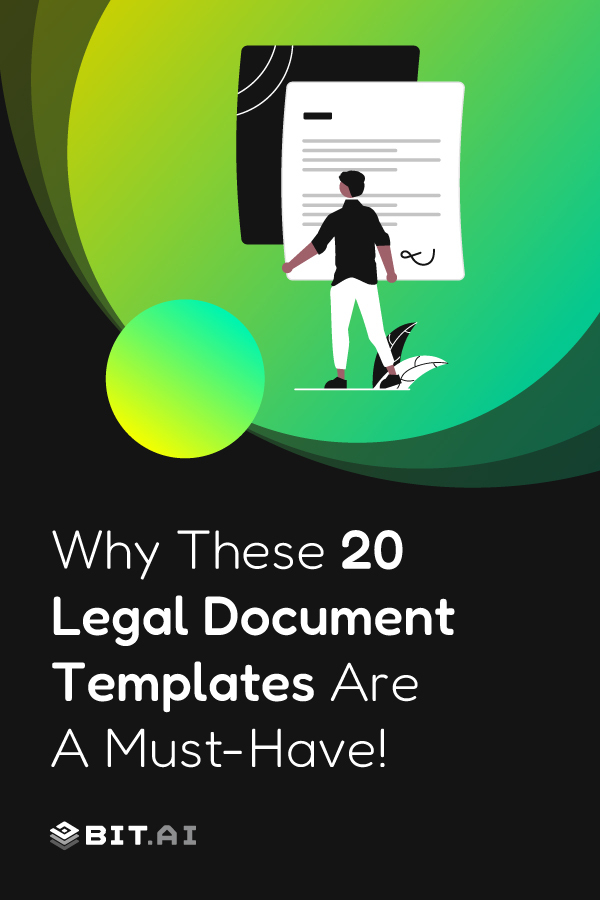Life can be messy, wonderful, and sometimes downright complicated. Even from the very beginning, legal documents play a surprising role in our journeys. That simple birth certificate you hold – that’s a legal document establishing your arrival in the world! It might seem like a small piece of paper, but throughout life, these documents can have a huge impact.
Whether you’re buying a house, starting a business, or simply planning for the future, having the right legal documents in place can save you time, money, and a whole lot of stress. They can protect your rights, ensure your wishes are carried out, and provide a clear roadmap in case things get bumpy.
Feeling overwhelmed by all the legalese? Don’t worry! This blog post is here to be your guide. We’ll break down the top 20 legal documents you’re likely to encounter in life, providing clear explanations of what they are and why they matter.
Plus, we’ll even throw in some handy template resources to get you started. So, buckle up and get ready to navigate the world of legal documents with confidence!
Top 20 Legal Document Templates for 2024
Business Legal Templates
1. Articles of Incorporation (LLC or Corporation)
The Articles of Incorporation is a foundational document for businesses electing to be a corporation or a limited liability company (LLC). It acts like a birth certificate, officially establishing your business with the state. It outlines key details about your company, including its existence and basic operating structure.
Why you need it:
- Legally establishes your business: It’s proof your company exists, separate from your personal finances.
- Defines ownership structure: It specifies who owns the company (shareholders for corporations, members for LLCs).
- Sets the stage for future filings: Having this document allows you to open bank accounts, obtain licenses, and comply with regulations.

Here’s a template on what to include in the document:
| Item | Description |
| Company Name | Your Business Name |
| Registered Agent | Name and address of the authorized person to receive legal documents |
| Duration | Perpetual (always existing) or specific end date |
| Purpose | Brief description of the business activities |
| Shares (Corporations only) | Total number authorized, description of different classes (if applicable) |
| Management Structure (LLCs only) | Member-managed or manager-managed |
| Dissolution (Optional) | Process for dissolving the company |
This is a simplified template. Requirements can vary by state. Always check with your Secretary of State for the specific format and information required. Consider consulting with a lawyer to ensure your Articles of Incorporation are accurate and meet your specific needs.
Read More: Top 20 Property Management Templates for 2025
2. Non-Disclosure Agreement (NDA)
A Non-Disclosure Agreement (NDA) is a legal contract used to protect confidential information shared between two or more parties. It essentially sets ground rules for keeping sensitive business information secret.
Why you need it:
- Protects your confidential information:
This can include trade secrets, marketing plans, customer lists, product ideas, or any other information you consider critical to your business advantage. - Builds trust during collaboration: An NDA establishes clear expectations about information sharing, fostering trust with potential partners, investors, or employees.
- Reduces risk of information leaks: By outlining legal consequences of breaches, NDAs deter unauthorized disclosure of your confidential information.
Here’s a template on what to include in the document:
| Item | Description |
| Parties Involved | Names and contact information of all parties disclosing or receiving confidential information |
| Confidential Information | Clear definition of what information is considered confidential (e.g., formulas, inventions, marketing strategies) |
| Permitted Use | Specifies how the receiving party can use the confidential information (e.g., for specific project only) |
| Confidentiality Obligations | Outlines how the receiving party will safeguard the confidential information (e.g., secure storage, limited access) |
| Term | Duration for which the NDA remains in effect (e.g., 1 year, 3 years, or perpetual) |
| Exceptions | outlines any situations where confidential information can be disclosed without penalty (e.g., legal requirement) |
| Remedies for Breach | Specifies legal actions that can be taken if the NDA is violated (e.g., injunction, lawsuit) |
| Signatures | Signatures and dates from all parties involved |
This is a simplified template. An NDA drafted by a lawyer is recommended to ensure it meets your specific needs and complies with state laws.
3. Commercial Lease Agreement
A commercial lease agreement is a legally binding contract between a landlord (property owner) and a tenant (business renting the property) outlining the terms and conditions for leasing commercial space. It’s crucial for both parties as it clarifies rights and responsibilities throughout the lease term.
Why you need it:
- Protects both parties:
- Landlord: Ensures rent is paid and property is used appropriately.
- Tenant: Defines expectations for the space and their rights as a renter.
- Reduces misunderstandings: Clearly outlines terms to avoid disputes over rent, maintenance, usage, etc.
- Serves as a reference: Provides a central document for both parties to reference throughout the lease.

Key Elements (consider including these in your agreement):
| Element | Description |
| Parties Involved | Names and contact information of Landlord and Tenant |
| Lease Term | Start and end date of the lease agreement |
| Leased Property | Description of the specific commercial space being rented (including square footage, address) |
| Rent | Amount of rent to be paid, frequency of payments (monthly, annually), and any late fees |
| Security Deposit | Amount of money held by the landlord as security for potential damages |
| Permitted Use | Approved business activities allowed on the property |
| Maintenance and Repairs | Who is responsible for maintaining the property and handling repairs |
| Utilities | Which utilities are included in the rent and which are tenant-paid |
| Default and Termination | Conditions that could lead to lease termination (e.g., non-payment of rent) |
| Renewal Option (Optional) | Option for the tenant to extend the lease at the end of the term |
This is not an exhaustive list. The specific terms of your agreement will vary depending on the property, negotiation between parties, and your state laws.
4. Employment Contract
An employment contract is a legally binding agreement between you (the employer) and your employee. It outlines the terms and conditions of employment, clarifying the expectations for both parties.
Why you need it:
- Protects your business: It sets clear guidelines on job duties, compensation, and confidentiality.
- Protects your employees: It clarifies their rights and benefits, fostering a positive work environment.
- Reduces misunderstandings: A clear contract minimizes confusion and potential disputes.
Template:
| Item | Description |
| Parties | Names and titles of the employer and employee |
| Start Date & Employment Term | Start date of employment and whether it’s for a specific period or ongoing |
| Job Title & Duties | Employee’s job title and a detailed description of their responsibilities |
| Compensation & Benefits | Salary/wages, bonuses, vacation/sick leave, health insurance, etc. |
| Confidentiality | Protects sensitive company information the employee may access |
| Intellectual Property | Ownership rights to any inventions or creations made during employment |
| Termination | Outlines reasons and procedures for termination by either party |
| Dispute Resolution | Method for resolving any disagreements arising from the contract |
| Signatures & Date | Both parties sign and date the contract |
Finance Legal Templates
Running a business involves various financial transactions, and having the proper legal documents in place is crucial. These finance legal templates act as pre-defined structures to ensure your financial dealings are clear, documented, and enforceable.
5. Loan Agreement
A loan agreement is a legally binding contract between a lender (who provides money) and a borrower (who receives money). It clearly outlines the terms and conditions of the loan, protecting both parties involved.
Template
Here’s a basic structure of a Loan Agreement template:
LOAN AGREEMENT
This Loan Agreement (“Agreement”) is made on [Date] between:
Lender: [Lender’s Full Name]
Address: [Lender’s Address]
Contact: [Lender’s Contact Information]
Borrower: [Borrower’s Full Name]
Address: [Borrower’s Address]
Contact: [Borrower’s Contact Information]
1. Loan Amount
The Lender agrees to loan the Borrower the principal sum of [Loan Amount] ([Loan Amount in Words]).
2. Interest Rate
The Loan shall bear an interest rate of [Interest Rate]% per annum.
3. Repayment Terms
The Borrower agrees to repay the Loan as follows:
- Payment Schedule: [e.g., Monthly/Quarterly]
- Payment Amount: [Amount Per Payment]
- Due Date: [Due Date of Each Payment]
4. Collateral
The Borrower shall provide the following collateral: [Description of Collateral, if applicable].
5. Default
In the event of default, the Lender may: [Describe actions that may be taken in case of default].
6. Governing Law
This Agreement shall be governed by and construed in accordance with the laws of the state of [State/Country].
7. Signatures
IN WITNESS WHEREOF, the parties hereto have executed this Loan Agreement as of the day and year first above written.
Lender’s Signature: ____________
[Lender’s Full Name]: ____________
Borrower’s Signature: ____________
[Borrower’s Full Name]: ____________

6. Security Agreement
A security agreement is a legal contract used to secure a loan. It creates a lien on specific collateral (assets) pledged by the borrower in case they default on the loan repayment. The lender can then seize and sell the collateral to recoup their losses.
Here’s what a Security Agreement typically covers:
| Item | Description |
| Parties Involved | Names and addresses of the borrower and lender |
| Loan Details | Loan amount, interest rate, repayment terms |
| Collateral Description | Specific identification and value of the pledged assets (e.g., equipment, inventory) |
| Covenants | Borrower’s obligations regarding the collateral (e.g., maintaining insurance, not selling the assets) |
| Default Provisions | Conditions that constitute a default (e.g., missed payments, filing for bankruptcy) |
| Repossession Rights | Lender’s legal right to take possession of the collateral upon default |
| Signatures | Both parties’ signatures and date |
7. Investment Prospectus
An investment prospectus is a legal document that offers a detailed picture of your company to potential investors. It essentially makes the case for why they should invest their money in your business. A well-crafted prospectus is critical for attracting investment and securing funding for your company’s growth.
Template:
INVESTMENT PROSPECTUS
Company Name: [Company Name]
Date: [Date]
1. Executive Summary
- Introduction: A brief introduction to the company and the investment opportunity.
- Investment Opportunity: Summary of the investment opportunity, including key benefits and potential returns.
2. Company Overview
- Business Description: Detailed description of the company’s business, products, or services.
- Market Analysis: Analysis of the market, including size, growth potential, and competitive landscape.
- Business Model: Explanation of the company’s business model and revenue streams.
3. Investment Details
- Offering Terms:
- Type of Security: [e.g., Equity, Debt]
- Number of Shares/Units: [Number]
- Price per Share/Unit: [Price]
- Minimum Investment: [Amount]
- Use of Proceeds: Description of how the funds raised will be used.
4. Risk Factors
- Market Risks: Description of risks related to the market and industry.
- Business Risks: Description of risks specific to the company’s business operations.
- Financial Risks: Description of financial risks, including liquidity and credit risks.
5. Financial Information
- Historical Financials: Summary of the company’s historical financial performance, including income statements, balance sheets, and cash flow statements.
- Projected Financials: Financial projections for the future, including revenue, profit, and cash flow forecasts.
6. Management Team
- Key Personnel: Biographies of key members of the management team and their relevant experience.
- Board of Directors: Information about the company’s board of directors.
7. Legal Information
- Regulatory Compliance: Statement regarding the company’s compliance with relevant laws and regulations.
- Legal Proceedings: Information about any legal proceedings involving the company.
8. Subscription Instructions
- How to Invest: Step-by-step instructions on how to subscribe to the investment offering.
- Contact Information: Contact details for the company’s investor relations team.

Read More: Profit Sharing Agreement: What is it & How to Create it?
8. Stock Purchase Agreement
A stock purchase agreement is a legal contract outlining the terms and conditions involved in buying or selling shares of stock in a privately held company. It safeguards both the buyer and seller by clearly defining their rights and obligations in the transaction.
Template:
While there’s no universal template, a stock purchase agreement typically follows this structure:
- Introduction: Identifies the agreement and the parties involved.
- Stock Purchase and Sale: Specifies the stock being sold, number of shares, and purchase price.
- Payment Terms: Outlines the payment method, schedule, and any escrow arrangements (holding funds in a neutral account until conditions are met).
- Representations and Warranties: Seller’s assurances about the company’s financial health and the stock’s validity.
- Closing Conditions: Conditions that must be satisfied before the sale is finalized.
- Indemnification: Allocation of liability for potential breaches of the agreement.
- Miscellaneous Provisions: Covers additional terms like confidentiality, governing law, and dispute resolution.
Personal Legal Templates
Personal legal documents help you plan for the future and protect yourself in various situations. Having access to templates can be a great starting point, but remember, these are general examples and may not cover all the specific details you need.
9. Last Will and Testament
A last will and testament, often shortened to just “will,” is a legal document that allows you to specify how you want your assets (belongings) to be distributed after you pass away. It also allows you to appoint a guardian for any minor children and an executor to handle the legal and financial aspects of settling your estate (everything you own).

Elements of Last Will and Testament Document:
- Testator Information: Your full name and residence.
- Beneficiaries: A list of individuals or organizations who will inherit your assets.
- Bequests: Specify what you want each beneficiary to receive (e.g., cash, property, specific items).
- Guardian for Minor Children (if applicable): Appoint someone to care for your children if they are underage.
- Executor: Choose a trusted person to manage the legal and financial aspects of settling your estate.
- Alternative Executor (optional): Name a backup person in case your primary executor cannot serve.
- Signature and Witnesses: The document must be signed by you and witnessed by two disinterested people (people who will not inherit from your will).
10. Power of Attorney
A power of attorney (POA) is a legal document that allows you (the Principal) to appoint another person (the Agent) to act on your behalf in financial, medical, or other personal matters. This can be particularly useful if you are unable to manage your affairs yourself due to illness, travel, or other reasons.
Types of Power of Attorney:
There are different types of POAs, each granting the agent specific authorities. Some common ones include:
- General Power of Attorney: Grants broad authority to handle a wide range of matters.
- Limited Power of Attorney: Limits the agent’s authority to specific tasks (e.g., managing finances, selling a car).
- Durable Power of Attorney: Remains valid even if you become incapacitated.
- Springing Power of Attorney: Takes effect only upon the occurrence of a specific event (e.g., medical condition).
Template:
While the specific format may vary by state, a power of attorney typically includes the following information:
| Item | Description |
| Principal | Your Name (the person granting the power) |
| Agent | Name and address of the person you appoint to act on your behalf |
| Powers Granted | A clear description of the specific tasks or decisions your agent is authorized to make |
| Effective Date | When the POA becomes valid |
| Expiration Date (Optional) | When the POA will no longer be valid |
| Signature of Principal | Your signature |
| Witness Signatures (May be required by your state) | Signatures of two witnesses |
| Notary Acknowledgment (Optional) | A notary public verifies your identity and your signing of the document (recommended in some cases) |
11. Prenuptial Agreement (Prenup)
A prenuptial agreement, often shortened to “prenup,” is a contract created between two people before they get married. It outlines how certain assets and finances will be divided if the marriage ends in divorce or legal separation.

Why you might need one:
- To protect premarital assets (property or finances owned before marriage).
- To clarify financial responsibility during the marriage (who pays what bills).
- To determine spousal support obligations in case of divorce.
- To manage inheritance rights for children from previous relationships.
Prenuptial Agreement
- Parties Involved: Full legal names and addresses of both partners.
- Separate Property: Identification of assets and debts considered separate property of each spouse before marriage.
- Marital Property: How marital property (assets and debts acquired during the marriage) will be divided in case of divorce.
- Spousal Support: Whether or not spousal support will be awarded in the event of divorce, and if so, the terms (amount and duration).
- Debt Responsibility: Allocation of responsibility for existing and future debts.
- Inheritance Rights: How inheritances will be handled in the event of divorce.
- Confidentiality: Whether the terms of the agreement will be kept confidential.
- Signatures: Both parties must sign and date the agreement, along with witnesses (requirements may vary by state).
12. Living Trust
A living trust is a legal document that allows you to transfer ownership of your assets (property, money, investments) to a trustee (a person or institution) you designate. The trustee manages the assets according to your instructions in the trust document, benefiting you while you’re alive and distributing the assets to your beneficiaries according to your wishes after you pass away.
Who should consider a Living Trust?
- Anyone who wants to avoid probate.
- People with complex estates or minor children.
- Individuals with concerns about disability.
Living Trust:
- Grantor(s): Your name(s)
- Trustee(s): Initial trustee(s) and successor trustee(s)
- Assets: List of assets transferred to the trust
- Management: Instructions for the trustee on how to manage the assets
- Distribution: Instructions for how the assets should be distributed to beneficiaries upon your passing or according to specific events.
- Powers of Attorney: You can include a power of attorney designation within the trust document.
Real Estate Legal Templates
Real estate transactions involve a multitude of legal documents to ensure clear communication, protect rights, and comply with regulations. Here’s a look at some of the most common real estate legal templates:
13. Real Estate Purchase Agreement
A real estate purchase agreement, also known as a sales agreement, is a legally binding contract between a buyer and seller outlining the terms and conditions of a property sale. It’s crucial for protecting both parties and ensuring a smooth transaction.
| Section | Description |
| Parties Involved | Names and contact information of buyer and seller. |
| Property Description | The legal description, address, and details of the property being sold. |
| Purchase Price | Agreed-upon price for the property. |
| Closing Date | Target date for closing the sale and transferring ownership. |
| Contingencies | Outlined conditions that must be met before the sale is final (e.g., financing approval, satisfactory inspections). |
| Earnest Money Deposit | Amount of deposit, who holds it (escrow agent), and conditions for its return. |
| Seller Disclosures | Disclosure of any known defects or issues with the property. |
| Title and Deed | Information on transferring ownership title and the deed. |
| Closing Cost | Breakdown of fees associated with closing (e.g., taxes, title insurance) and who is responsible for each cost. |
| Inspections | Timeline for scheduling and completing property inspections (e.g., home inspection, pest inspection). |
| Default Provisions | Consequences if buyer or seller fails to fulfill their obligations (e. g., breach of contract) |
| Signatures | Designated lines for buyer, seller, and witnesses to sign and date the agreement. |

Read More: Consulting Agreement or Contract: What is it & How to Create it?
14. Residential Lease Agreement
A residential lease agreement, also referred to as a rental agreement, is a legally binding contract between a landlord and a tenant. It outlines the terms and conditions under which a tenant rents a residential property from a landlord. This agreement protects both parties by clearly stating their rights and responsibilities.
Template:
| Clause | Description |
| Parties | Names and contact information of Landlord and Tenant(s). |
| Property Description | Address and details of the rental unit. |
| Term of Lease | Start and end date of the rental agreement. |
| Rent | Monthly rent amount, due date, and acceptable payment methods. |
| Security Deposit | Amount, terms for holding and returning the deposit. |
| Utilities | Responsibilities for paying utilities (electric, water, trash, etc.). |
| Maintenance and Repairs | Responsibilities of landlord and tenant regarding repairs and upkeep. |
| Use of Property | Restrictions on use (e.g., occupancy limits, subletting, pets). |
| Access | Landlord’s right to access the property for repairs or emergencies. |
| Termination | Conditions under which either party can terminate the lease early. |
15. Homeowners Association (HOA) Rules and Regulations
The homeowners association (HOA) rules and regulations is a legal document outlining the expectations and guidelines for homeowners within a community governed by an HOA. It essentially functions as a contract between the HOA and each homeowner, specifying their rights and responsibilities in maintaining a cohesive and functional neighborhood.
Some common sections include:
- Administrative Matters: Details HOA structure, board member election process, and meeting procedures.
- Property Maintenance: Outlines expectations for maintaining exteriors, landscaping, and adhering to architectural guidelines.
- Use of Common Areas: Establishes rules for using pools, gyms, clubhouses, and other shared amenities.
- Noise Restrictions: Defines acceptable noise levels and limitations on disruptive activities during specific times.
- Parking and Storage: Specifies parking regulations, guest parking limitations, and restrictions on storing vehicles or personal items in driveways or common areas.
- Pets: Defines pet ownership limitations, leash requirements, and waste disposal procedures.
- Trash and Recycling: Outlines guidelines for proper trash and recycling disposal.
- Dispute Resolution: Establishes a process for addressing neighborly disputes and violations of the HOA rules.

16. Deed
A Deed is a legal document that transfers ownership of real property (land and anything permanently attached to it) from one party (grantor) to another (grantee). It’s essential for finalizing real estate transactions and serves as official proof of ownership transfer.
Types of Deeds:
- Grant Deed: The most common type, offering the strongest warranties from the grantor about the property’s title and condition.
- Quitclaim Deed: Transfers ownership without any warranties. Often used to clear up title issues or transfer property between family members.
- Warranty Deed: Similar to a Grant Deed, but with slightly fewer guarantees about the property’s history.
What a Deed Typically Includes:
- Grantor and Grantee Information: Names and addresses of both parties involved in the transfer.
- Property Description: Legal description of the real estate being transferred.
- Warranties (Grant Deed only): Guarantees from the grantor regarding the property’s title and condition (varies by state).
- Covenants (Optional): Restrictions or promises regarding the use of the property.
- Signatures: Both grantor and grantee (and possibly witnesses) must sign and acknowledge the deed.
Estate Planning Legal Templates
Estate planning isn’t just for the wealthy. It’s about ensuring your wishes are followed regarding your assets and loved ones after you pass away. Here’s a look at some key estate planning documents and a basic structure for each
17. Living Will
A living will, also known as a directive to physicians, is a legal document that allows you to express your wishes for medical treatment in the event you are incapacitated and unable to make decisions for yourself. It focuses on life-sustaining treatments, such as artificial respiration or tube feeding.
Why you need it:
- Makes your wishes known: Ensures your medical care aligns with your values and beliefs.
- Reduces burden on loved ones: Provides clear guidance for your family during a difficult time.
- Promotes patient autonomy: Gives you control over your medical care even when you can’t speak for yourself.
Template of Living Will:
- Declarant: Your Name
- Statement of Intent: Clearly state this document expresses your wishes for medical treatment.
- Life-Sustaining Treatments:
- Directions: Specify your wishes regarding use of life-sustaining treatments (e.g., artificial respiration, tube feeding). You can choose to accept, refuse, or request a trial period.
- Conditions: Outline specific circumstances under which your wishes would apply (e.g., terminal illness, permanent unconscious state).
- Pain Management: Indicate your desire for pain medication and comfort care, even if it shortens your life expectancy.
- Organ Donation (Optional): State your wishes regarding organ or tissue donation.
- Appointment of Healthcare Proxy (Optional): Designate someone you trust to make medical decisions on your behalf if you are unable.
- Signatures: Include your signature and witness signatures, following your state’s specific requirements.

18. Durable Power of Attorney for Healthcare
A durable power of attorney for healthcare, also known as a healthcare proxy, is a legal document that allows you to appoint someone you trust to make medical decisions on your behalf if you become incapacitated and unable to make them yourself. This can be due to illness, injury, or unconsciousness.
Template:
- Your Name (Principal): The person creating the document.
- Agent Name(s): The person(s) you appoint to make healthcare decisions for you. You can name one person or multiple backups.
- Commencement of Authority: When the agent’s authority begins (e.g., immediately upon signing, or upon your incapacity).
- Scope of Authority: A clear description of the types of medical decisions your agent is authorized to make.
- Limitations of Authority: Any specific treatments or decisions you do not want your agent to make.
- HIPAA Release Authorization: Allows your agent to access your medical records.
- Signature and Witnesses: The document must be signed by you, the principal, and witnessed by a certain number of people (varies by state).
19. Beneficiary Designation
A beneficiary designation is a simple yet powerful tool used to specify who inherits certain assets upon your death. These assets are typically held outside of a will and bypass the probate process, making them easier and faster to distribute to your beneficiaries.
Template:
| Account Type | Beneficiary Information |
| Life Insurance Policy | [Name of Beneficiary(ies)] – [Percentage or Specific Amount (Optional)] |
| Retirement Account (IRA, 401(k)) | [Name of Beneficiary(ies)] – [Percentage or Specific Amount (Optional)] |
| Investment Account | [Name of Beneficiary(ies)] – [Type of Ownership (e.g., Tenants in Common, Transfer on Death)] |
| Payable-on-Death (POD) Bank Account | [Name of Beneficiary(ies)] |
20. Letter of Intent
A letter of intent (LOI) is a non-binding document that outlines the preliminary terms of an agreement between two parties regarding an estate matter. It’s commonly used in estate planning situations like:
- Selling a business to a family member
- Distributing assets among beneficiaries
An LOI helps establish a good faith understanding of the key aspects of the agreement before diving into formal legal contracts.

What it includes:
- Parties Involved: Identifies those involved in the potential agreement (e.g., executor, beneficiaries).
- Subject of the Agreement: Briefly describes the estate asset or property in question.
- Key Terms: Outlines the main points of the proposed agreement, such as sale price, distribution percentages, or timelines.
- Next Steps: Indicates the intention to move forward with formalizing the agreement and outlines any deadlines for further discussions.
Final Thoughts
Legal documents can seem complex and intimidating, but having access to templates can be a valuable starting point. This list has explored a variety of templates across different legal areas, highlighting their importance and providing a basic structure.
Here are some key takeaways:
- Templates are a starting point: They offer a framework, but legal requirements can vary by state and situation.
- Legal advice is crucial: Don’t rely solely on templates. Consult with an attorney to ensure your documents are accurate, compliant, and meet your specific needs.
- Seek professional help for complex documents: For intricate documents like investment prospectuses or estate plans, consulting with a lawyer is highly recommended.
By understanding the purpose of these legal documents and using templates as a guide, you can approach your legal needs with more confidence. Remember, legal advice is always best to ensure your documents are watertight and protect your interests.
Conclusion
Having the right legal document templates ready and available can save time, provide clarity, and mitigate potential disputes. These 20 templates are indispensable for individuals and businesses gearing up for a successful 2024. Be proactive and ensure you have these documents tailored to your specific needs!
Further Reads:
Top 20 User Manual Templates: A Guide to Their Uses and Applications
Types of Employment Contracts Every Employer Should Know!
Freelance Contract: What is it & How to write it? (Steps)
2024’s Ultimate Document Template Guide For Modern Educators


